Thermal Performance and Comfort Conditions Analysis of a Vernacular Palafitic Timber Building in Portuguese Coastline Context
Abstract
1. Introduction
2. Materials and Methods
2.1. Short-Term Monitoring
- Objective measurements—with the purpose of quantitatively assess the thermal comfort conditions in a room. A thermal microclimate station (model Delta OHM 32.1) that measures air temperature, relative humidity, mean radiant temperature and air velocity (Table 1), in compliance with standards ISO 7726 [17], ISO 7730 [18] and ASHRAE 55 [19], was used for this purpose. The measurements were performed in several rooms, especially where occupant’s stay for more extended periods. The measuring equipment was placed according to occupants’ distribution in the room. The measurements were performed considering that the occupants were seated, as recommended in ASHRAE 55 [19]. The data recorded in these measurements was used to determine the operative temperature (the analysis procedure is explained below in this section).
2.2. Long-Term Monitoring
2.3. Thermal Comfort Model
2.4. Energy Performance Model
3. Description of the Case Study
3.1. Site and Climate
3.2. Case Study Building
3.3. Site-Responsive Strategies
- The material used, that is, timber, was the most suitable and viable in this context, not only due to the scarcity of other materials but also because of the difficulty to build with these materials in areas of alluvium and sand. In the Portuguese context, this type of construction is common to other fishing settlements in coastal and riverside areas [13,29,38], confirming the experience and the viability in these contexts. Although the ethnologists Oliveira and Galhano [29] say that this preference is also due to the lower construction cost, the constraints of the site seem to overcome the cost. In the case of Praia de Mira, the suitability is demonstrated by the use of the material available nearby. The palheiros were built with timber from Gândara area, from a zone between Mira and Cantanhede (≈10–20 km from Praia de Mira). As the pine forests that exist today in the vicinity of the village are from the beginning of the 20th century, planted to contain the advance of sand over arable and productive land [39,40]. Although the higher distance, when compared with other vernacular materials, the versatility of timber and ease of transport were advantages [41];
- The lightweight of timber construction favored the adaptability to sandy soil and dunes morphology [13]. Due to this feature, the buildings were raised above the ground on pillars, which allow the sand dragged by the wind to flow underneath the building, preventing its accumulation on the walls [13,28,29,30,42] (Figure 10a). Moreover, when needed, the building could be raised higher and the pillars pulled or added or even moved to another place [13];
- Regarding the external coating, as a rule, the wooden boards were laid out horizontally, overlapping as scales, to ensure better protection from the wind, sand and rain [32]. The structure of the walls, reinforced at the corners by diagonal struts, was characterized by the large number of plumbs that allowed the boards to be arranged horizontally (in some cases with a rabbet joint) [33]. Although this technique seems more basic and simpler than the system of vertical boards with joint seal (which has fewer infiltrations), it allows to repel water and sand by gravity better;
- The possibility of maintenance and replacement piece-by-piece is an interesting feature of these buildings [9,43]. Although the timber construction works correctly concerning the sandy floor and sea-salty moisture [13] and as it is an organic material its durability is influenced by atmospheric agents and the action of insects and fungi, beyond being susceptible to combustion [41]. It was possible to overcome this apparent weakness with periodic maintenance of foundations and coating. After construction, the outer coating timber was impregnated with sil (sardine oil, produced locally) that together with the sea air, saturated with salt, made it extraordinarily resistant [44]. After painting, the operation was usually only repeated after three years [38]. Later, they start to use burned oil from the boat’s engines instead of sil [28]. In the case of the pillars, to prevent or delay their degradation due to contact with soil’s moisture, they were sometimes coated with asphaltic bitumen (named piche) [28]. As the building has several independent parts, it makes it easy to disassemble and thus to perform individual replacement of the degraded pieces. In the “Type of Mira” construction system, the distance between the pillars is higher than that of the plumbs, thus these could be easily replaced when rotted or when necessary to raise the building due to the movement of the dunes [41];
- The moisture buffering capacity of timber structures [45,46] and the relatively low thermal conductivity of pine wood (0.18 W/(m·°C) [16]), were adequate responses to local climate (sea moisture, moderate temperature and wind speed) and had a positive effect in indoor environmental quality. This behavior is due to the hygroscopic properties of timber. Thus, they can exchange water vapor with the surrounding air continuously, that is, gaining and losing moisture until reaching an equilibrium point (equilibrium moisture content–EMC) [45,46]. The EMC is influenced by relative humidity and temperature and any change in these parameters force the material to adjust to a new equilibrium point [46]. In the case of Maritime Pine (Pinus pinaster), the wood used in the palheiros, it has the higher EMC (12.8%) and also the lower ability to shrink and swell, from three softwood species largely applied in the European construction sector [45]. This passive feature of timber structures is an advantage in this type of climate since it can tolerate and regulate moisture more than other materials. For example, concrete structures take more than twice as long to dry out as does a timber wall [7] and lightweight timber structures reveal to have constant and stable moisture fluctuations during different seasons [47].
- The promotion of natural ventilation is particularly relevant in a humid environment. These buildings, frequently had windows in opposite façades, which favors cross-ventilation and good indoor air quality;
- The urban layout, although not planned, shows an intention of a structured organization and a purpose of shelter, with the buildings implanted around the lagoon and sheltered from the wind by the dunes (Figure 3b). Moreover, the warehouses for storing fishnets and other fishing tools were implanted facing the sea, which besides being easier to support fishing, would work as a barrier against the wind, protecting the buildings. The permanent buildings were implanted in the sheltered slope of the dunes and, most of them, with their back facing the sea (Figure 10b).
3.4. Occupancy Profile
4. Thermal Monitoring and Indoor Comfort Evaluation
4.1. Winter
4.2. Spring
4.3. Summer
4.4. Autumn
5. Energy Performance
- the characteristics of the envelope (U-value, density, etc.) are the same as calculated for the original buildings, considering properties values from technical publications [16,25]. For other thermo-physical properties as specific heat, thermal diffusivity and so forth, were considered the values available in DesignBuilder materials library;
- the minimum air change rate had into consideration the recommendations of EN 16798-1 standard [48] for new residential buildings (Category II) [48]. Although the case study is an Ethnographic Museum and Tourist Office, the building has a low occupancy density and the considered value of 0.6 ach is adequate and higher than the minimum required for a low polluting building. To simplify the models and to assure a minimum constant air change rate per hour in the building, it was considered the existence of a mechanical ventilation system. Nonetheless, natural ventilation strategies are very relevant in vernacular buildings, particularly during summer. For this reason, in the building model, the calculated natural ventilation model option was activated, which provided additional data to control the timing and extent of operation of openings. Therefore, when the windows and doors are in operation, the air change rate is incremented, based on opening size and wind pressure;
- the values or conditions for internal gains, heating and cooling temperature setpoints and maximum U-values for external walls follow the preconized in national legislation on the Energy Performance of Buildings [15].
- (i)
- Original building wall (wooden planks (1.5 cm) + air gap (7 cm) + XPS (3 cm) + indoor timber plank (1.2 cm); U-value = 0.81 W/(m2·°C));
- (ii)
- Double hollow clay brick cavity wall (render (2 cm) + clay brick (15 cm) + air gap (3 cm) + XPS (2 cm) + clay brick (11 cm) + render (2 cm); U-value = 0.82 W/(m2·°C) (considering thermal bridges));
- (iii)
- Hollow clay brick + ETICS (External Thermal Insulation Composite System) wall (Render (2 cm) + clay brick (22 cm) + render (1 cm) + EPS (6 cm) + render (0.5 cm); U-value = 0.40 W/(m2·°C));
- (iv)
- Timber cavity wall with insulation (wooden planks (1.5 cm) + air gap (2 cm) + ICB (8 cm) + indoor timber plank (1.2 cm); U-value = 0.40 W/(m2·°C));
- (v)
- Timber cavity wall without insulation (wooden planks (1.5 cm) + air gap (10 cm) + indoor timber plank (1.2 cm); U-value = 2.39 W/(m2·°C)).
6. Conclusions
Author Contributions
Funding
Acknowledgments
Conflicts of Interest
References
- European Parliament and the Council of the European Union. Directive (EU) 2018/844 of the European Parliament and of the Council of 30 May 2018 Amending Directive 2010/31/EU on the Energy Performance of Buildings and Directive 2012/27/EU on Energy Efficiency; European Parliament and the Council of the European Union: Brussels, Belgium, 2018; pp. 75–91. [Google Scholar]
- European Comission. A Clean Planet for All a European Strategic Long-Term Vision for a Prosperous, Modern, Competitive and Climate Neutral Economy; European Commision: Brussels, Belgium, 2018. [Google Scholar]
- Fernandes, J.; Peixoto, M.; Mateus, R.; Gervásio, H. Life cycle analysis of environmental impacts of earthen materials in the Portuguese context: Rammed earth and compressed earth blocks. J. Clean. Prod. 2019, 241, 118286. [Google Scholar] [CrossRef]
- Adekunle, T.O.; Nikolopoulou, M. Thermal comfort, summertime temperatures and overheating in prefabricated timber housing. Build. Environ. 2016, 103, 21–35. [Google Scholar] [CrossRef]
- Pajek, L.; Hudobivnik, B.; Kunič, R.; Košir, M. Improving thermal response of lightweight timber building envelopes during cooling season in three European locations. J. Clean. Prod. 2017, 156, 939–952. [Google Scholar] [CrossRef]
- Pittau, F.; Dotelli, G.; Arrigoni, A.; Habert, G.; Iannaccone, G. Massive timber building vs. conventional masonry building. A comparative life cycle assessment of an Italian case study. IOP Conf. Ser. Earth Environ. Sci. 2019, 323, 012616. [Google Scholar] [CrossRef]
- Berge, B. The Ecology of Building Materials, 2nd ed.; Elsevier: Oxford, UK, 2009; ISBN 9781856175371. [Google Scholar]
- Fraanje, P.J. Cascading of pine wood. Resour. Conserv. Recycl. 1997, 19, 21–28. [Google Scholar] [CrossRef]
- Fernandes, J. O contributo da arquitectura vernacular portuguesa para a sustentabilidade dos edifícios. Master’s Thesis, Universidade do Minho, Braga, Portugal, 2012. [Google Scholar]
- Coelho, A.; Branco, J.; Gervásio, H. Life-cycle assessment of a single-family timber house. In Proceedings of the BSA 2012: 1st International Conference on Building Sustainability Assessment, Porto, Portugal, 23–25 May 2012; Amoêda, R., Mateus, R., Bragança, L., Pinheiro, C., Eds.; Greenlines Institute for Sustainable Development: Porto, Portugal, 2012; pp. 533–542. [Google Scholar]
- Adekunle, T.O.; Nikolopoulou, M. Winter performance, occupants’ comfort and cold stress in prefabricated timber buildings. Build. Environ. 2019, 149, 220–240. [Google Scholar] [CrossRef]
- Tonelli, C.; Grimaudo, M. Timber buildings and thermal inertia: Open scientific problems for summer behavior in Mediterranean climate. Energy Build. 2014, 83, 89–95. [Google Scholar] [CrossRef]
- AAVV. Arquitectura Popular em Portugal, 3rd ed.; Associação dos Arquitectos Portugueses: Lisboa, Portugal, 1988. [Google Scholar]
- EU Directive 2012/27/EU of the European Parliament and of the Council of 25 October 2012 on Energy Efficiency, Amending Directives 2009/125/EC and 2010/30/EU and Repealing Directives 2004/8/EC and 2006/32/EC; Official Journal of the European Union: Strasbourg, France, 2012.
- Decreto-Lei 118/2013: Sistema de Certificação Energética dos Edifícios, o Regulamento de Desempenho Energético dos Edifícios de Habitação (REH) e o Regulamento de Desempenho Energético dos Edifícios de Comércio e Serviços (RECS); Diário da República: Lisboa, Portugal, 2013.
- Pina dos Santos, C.A.; Matias, L. ITE50—Coeficientes de Transmissão Térmica de Elementos da Envolvente dos Edificios; Laboratório Nacional de Engenharia Civil/National Laboratory of Civil Engineering: Lisboa, Portugal, 2006.
- ISO7726 Ergonomics of the Thermal Environment e Instruments for Measuring Physical Quantities; International Organization for Standardization (ISO): Geneva, Switzerland, 2002.
- ISO7730 Ergonomics of the Thermal Environment: Analytical Determination and Interpretation of Thermal Comfort Using Calculation of the PMV and PPD Indices and Local Thermal Comfort Criteria; International Organization for Standardization (ISO): Geneva, Switzerland, 2005.
- ASHRAE ASHRAE 55—Thermal Environmental Conditions for Human Occupancy; ANSI/ASHRAE Standard 55 Ashrae: Atlanta, GA, USA, 2013.
- Matias, L.; Almeida, S.; Pina Santos, C.; Rebelo, M.; Correia Guedes, M. Adaptive Thermal Comfort for Buildings in Portugal based on Occupants’ Thermal Perception. In Proceedings of the PLEA2009—26th Conference on Passive and Low Energy Architecture: Architecture Energy and the Occupant’s Perspective, Quebec City, QC, Canada, 22–24 June 2009; Demers, C., Potvin, A., Eds.; Les Presses de l’Université Laval: Quebec City, QC, Canada, 2009; pp. 22–24. [Google Scholar]
- Matias, L. TPI65—Desenvolvimento de um Modelo Adaptativo Para Definição das Condições de Conforto Térmico em Portugal; Laboratório Nacional de Engenharia Civil/National Laboratory of Civil Engineering: Lisboa, Portugal, 2010; ISBN 978-972-49-2207-2.
- ASHRAE ANSI/ASHRAE Standard 55—Thermal Environmental Conditions for Human Occupancy; ASHRAE: Atlanta, GA, USA, 2004.
- EN15251 Indoor Environmental Input Parameters for Design and Assessment of Energy Performance of Buildings-Addressing Indoor Air Quality, Thermal Environment, Lighting and Acoustics; European Committee for Standardization: Paris, France, 2007.
- DesignBuilder Software Ltd DesignBuilder v6—Energy Simulation Software. Available online: https://designbuilder.co.uk/ (accessed on 10 June 2020).
- Pina dos Santos, C.A.; Rodrigues, R. ITE54—Coeficientes de Transmissão Térmica de Elementos Opacos da Envolvente dos Edificios; Laboratório Nacional de Engenharia Civil/National Laboratory of Civil Engineering: Lisboa, Portugal, 2009; ISBN 978-972-49-2180-8.
- Wasilowski, H.A.; Reinhart, C.F. Modelling an existing building in designbuilder/energyplus: Custom versus default inputs. In Proceedings of the Building Simulation 2009—Eleventh International IBPSA Conference, Glasgow, UK, 27–30 July 2009; International Building Performance Simulation Association: Glasgow, UK, 2009; pp. 1252–1259. [Google Scholar]
- Energy Plus Weather Data by Region: Portugal. Available online: https://energyplus.net/weather-region/europe_wmo_region_6/PRT (accessed on 10 June 2020).
- De Brito, R.S. Palheiros de Mira: Formação e declínio de um aglomerado de pescadores, 2nd ed.; Centro de Estudos Geográficos da Universidade de Lisboa: Lisboa, Portugal, 1981. [Google Scholar]
- Oliveira, E.V.; Galhano, F. Arquitectura Tradicional Portuguesa; Publicações Dom Quixote: Lisboa, Portugal, 1992. [Google Scholar]
- Ribeiro, O. Geografia e Civilização—Temas Portugueses, 4th ed.; Livraria Letra Livre: Lisboa, Portugal, 2013; ISBN 978-989-8268-16-7. [Google Scholar]
- Reigota, J. A Gândara Antiga. Concelhos de Cantanhede, Mira e Vagos; Centro de Estudos do Mar e das Navegações Luís Albuquerque—CEMAR: Cantanhede–Mira–Vagos, Portugal, 2000; ISBN 972-8289-19-7.
- Rocha Peixoto, A. Etnografia Portuguesa: Obra etnográfica completa; Publicações Dom Quixote: Lisboa, Portugal, 1990; ISBN 972-20-0766-1. [Google Scholar]
- De Oliveira, E.V.; Galhano, F. Palheiros do Litoral Central Português; Instituto de Alta cultura—Centro de Estudos de Etnografia Peninsular: Lisboa, Portugal, 1964. [Google Scholar]
- Teixeira, G.; Belém, M. Diálogos de Edificação: Estudo de técnicas tradicionais de construção; CRAT—Centro Regional de Artes Regionais: Porto, Portugal, 1998. [Google Scholar]
- AEMET. IM Atlas Climático Ibérico: Temperatura do Ar e Precipitação (1971-2000)/Iberian Climate Atlas: Air Temperature and Precipitation (1971/2000); Instituto de Meteorologia de Portugal, Ed.; Agencia Estatal de Meteorología—Ministerio de Medio Ambiente y Medio Rural y Marino: Madrid, Spain, 2011; ISBN 978-84-7837-079-5.
- Ribeiro, O. Portugal: O Mediterrâneo e o Atlântico, 7th ed.; Livraria Sá da Costa Editora: Lisboa, Portugal, 1998; ISBN 972-569-320-7. [Google Scholar]
- IPMA Portal do Clima/Climate Change Portal. Available online: http://portaldoclima.pt/en/# (accessed on 4 March 2020).
- Silva, M.; Mendonça, P.; Branco, J. Reabilitação de casas tradicionais em madeira do litoral norte e centro de Portugal. In Proceedings of the CIMAD 11—1o Congresso Ibero-Latino Americano da Madeira na Construção, Coimbra, Portugal, 7–9 June 2011; Coimbra University: Coimbra, Portugal, 2011; pp. 1–10. [Google Scholar]
- Rei, M.A. Pinhais e Dunas de Mira—Subsídios Para a Sua História; M.A. Rei: Figueira da Foz, Portugal, 1924. [Google Scholar]
- Vieira, J.N. Árvores e Florestas de Portugal Vol. 1: Floresta Portuguesa—Imagens de tempos idos; Silva, J.S., Ed.; Público, Comunicação Social, S.A. e Fundação Luso-Americana para o Desenvolvimento: Lisbon, Portugal, 2007; ISBN 978-989-619-098-9. [Google Scholar]
- Moutinho, D.F.O. Edifícios de Construção Tradicional em Madeira. Bachelor Thesis, FAUP, Porto, Portugal, 2007. [Google Scholar]
- Cachim, P.B. Construção em Madeira—A Madeira como Material de Construção, 2nd ed.; Publindústria: Porto, Portugal, 2014; ISBN 978-989-723-052-3. [Google Scholar]
- Fernandes, J.; Mateus, R.; Bragança, L. The potential of vernacular materials to the sustainable building design. In Proceedings of the Vernacular Heritage and Earthen Architecture: Contributions for Sustainable Development, Vila Nova de Cerveira, Portugal, 16–20 October 2013; Correia, M., Carlos, G., Rocha, S., Eds.; CRC Press: Vila Nova de Cerveira, Portugal, 2013; pp. 623–629. [Google Scholar]
- Chaves, M.A.G.A. Do Mar e da Terra: Palheiros e Pescadores do Furadouro e Ovar; Edições Afrontamento: Porto, Portugal, 2008; ISBN 978-972-36-0951-6. [Google Scholar]
- Silva, C.; Branco, J.M.; Camões, A.; Lourenço, P.B. Dimensional variation of three softwood due to hygroscopic behavior. Constr. Build. Mater. 2014, 59, 25–31. [Google Scholar] [CrossRef][Green Version]
- Hartley, I.; Hamza, M.F. Wood: Moisture Content, Hygroscopicity, and Sorption. In Reference Module in Materials Science and Materials Engineering; Elsevier Ltd.: Amsterdam, The Nethedlands, 2016; pp. 1–8. ISBN 9780128035818. [Google Scholar]
- Lee, J.; Wi, S.; Chang, S.J.; Choi, J.; Kim, S. Prediction evaluating of moisture problems in light-weight wood structure: Perspectives on regional climates and building materials. Build. Environ. 2020, 168, 106521. [Google Scholar] [CrossRef]
- CEN EN 16798-1:2019. Energy Performance of Buildings—Ventilation for Buildings—Part 1: Indoor Environmental Input Parameters for Design and Assessment of Energy Performance of Buildings Addressing Indoor Air Quality, Thermal Environment, Lighting and Acoustics; European Committee for Standardization: Brussels, Belgium, 2019. [Google Scholar]
- Cooper, D.; McDermott, M.; Wartofsky, L. Hyperthyroidism. J. Clin. Endocrinol. Metab. 2006, 91, E2. [Google Scholar] [CrossRef]
- Mendonça, P. Habitar sob uma segunda pele: Estratégias para a redução do impacto ambiental de construções solares passivas em climas temperados. Ph.D. Thesis, University of Minho, Braga, Portugal, 2005. [Google Scholar]
- Eurostat Energy Statistics—Cooling and Heating Degree Days (nrg_chdd). Available online: https://ec.europa.eu/eurostat/cache/metadata/en/nrg_chdd_esms.htm (accessed on 11 November 2020).
- U.S. Environmental Protection Agency. Heating and Cooling Degree Days; U.S. Environmental Protection Agency: Washington, DC, USA, 2016.
- Simpson, W.T. Equilibrium Moisture Content of Wood in Outdoor Locations in the United States and Worldwide; Forest Products Laboratory: Madison, WI, USA, 1998.
- Rode, C.; Peuhkuri, R.; Time, B.; Svennberg, K.; Ojanen, T.; Mukhopadhyaya, P.; Kumaran, M.; Dean, S.W. Moisture Buffer Value of Building Materials. J. ASTM Int. 2007, 4, 1–12. [Google Scholar] [CrossRef]
- Rode, C.; Grau, K. Moisture buffering and its consequence in whole building hygrothermal modeling. J. Build. Phys. 2008, 31, 333–360. [Google Scholar] [CrossRef]
- Antunes, C.; Rocha, C.; Catita, C. Coastal flood assessment due to sea level rise and extreme storm events: A case study of the atlantic coast of Portugal’s mainland. Geosciences 2019, 9, 239. [Google Scholar] [CrossRef]
- Rocha, C.; Antunes, C.; Catita, C. Coastal vulnerability assessment due to sea level rise: The case study of the Atlantic coast of Mainland Portugal. Water 2020, 12, 360. [Google Scholar] [CrossRef]
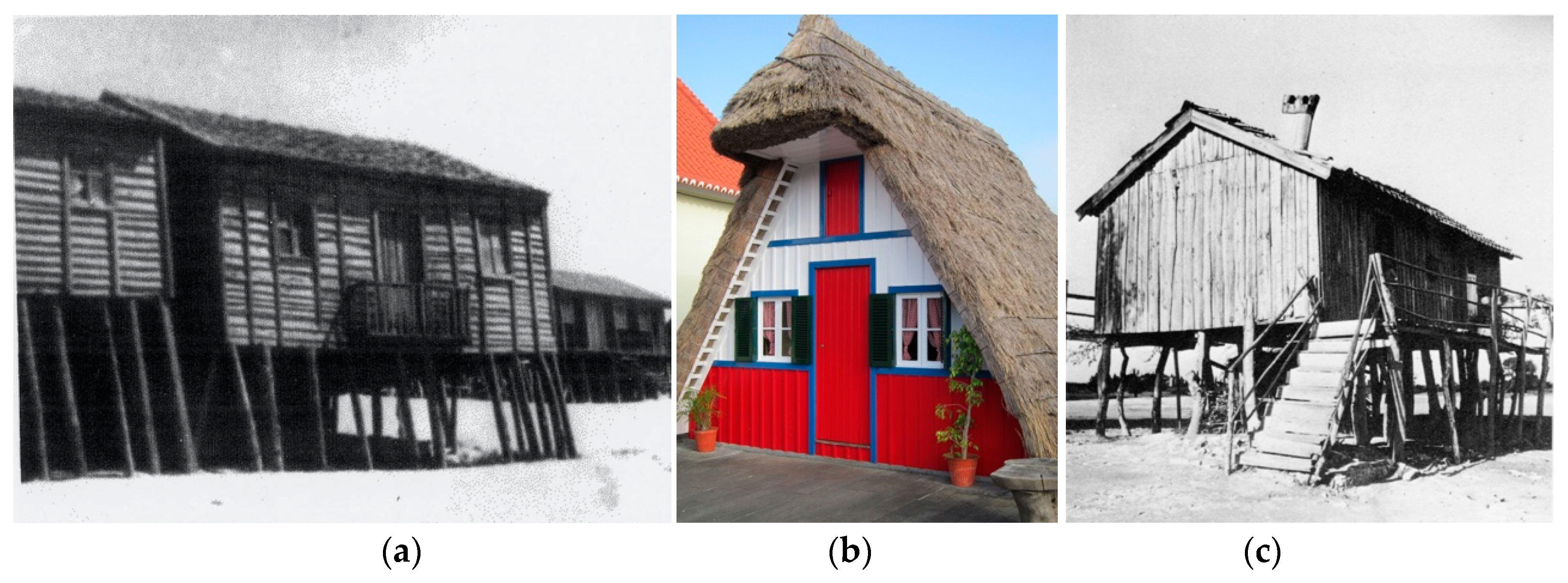
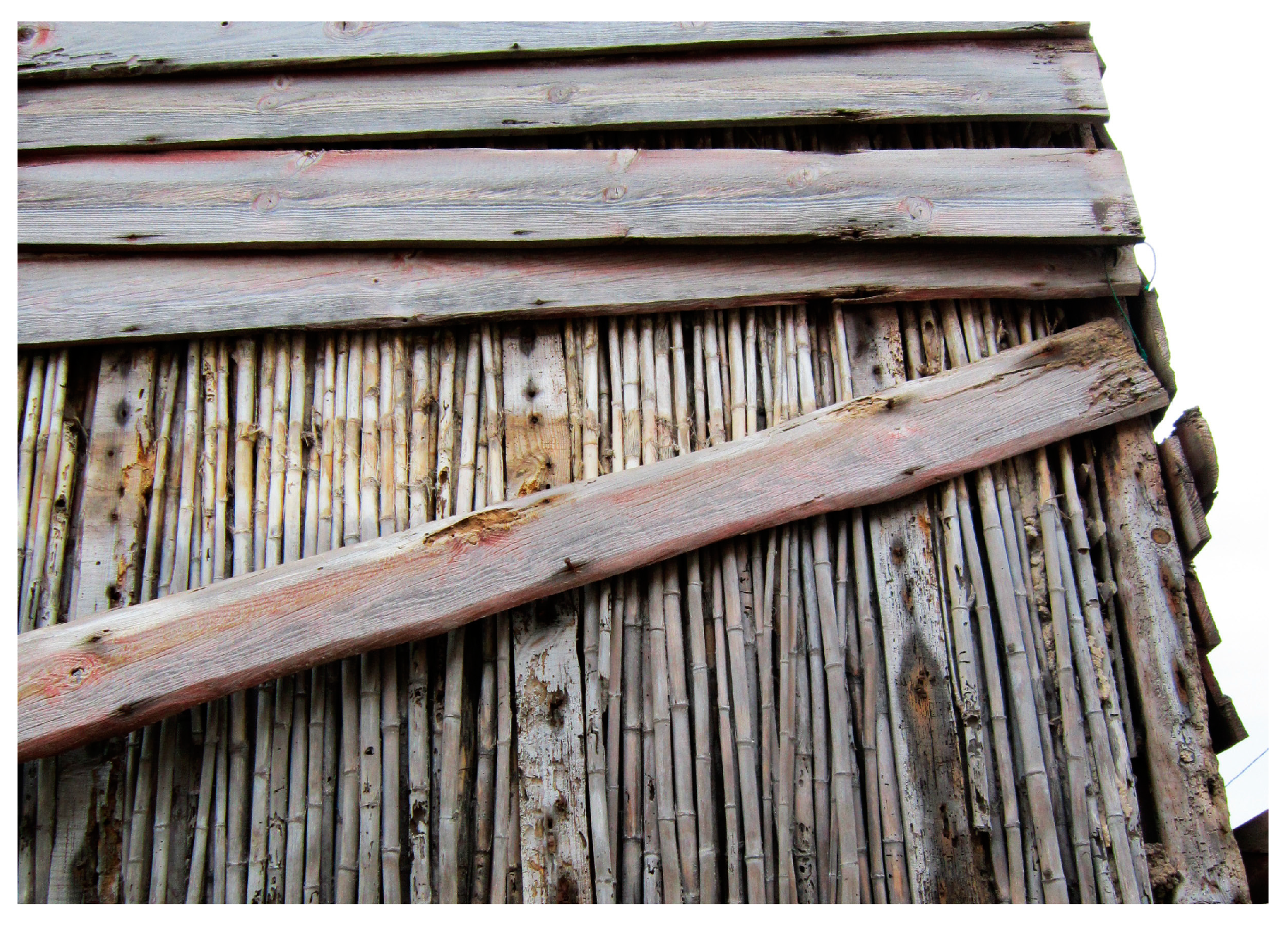


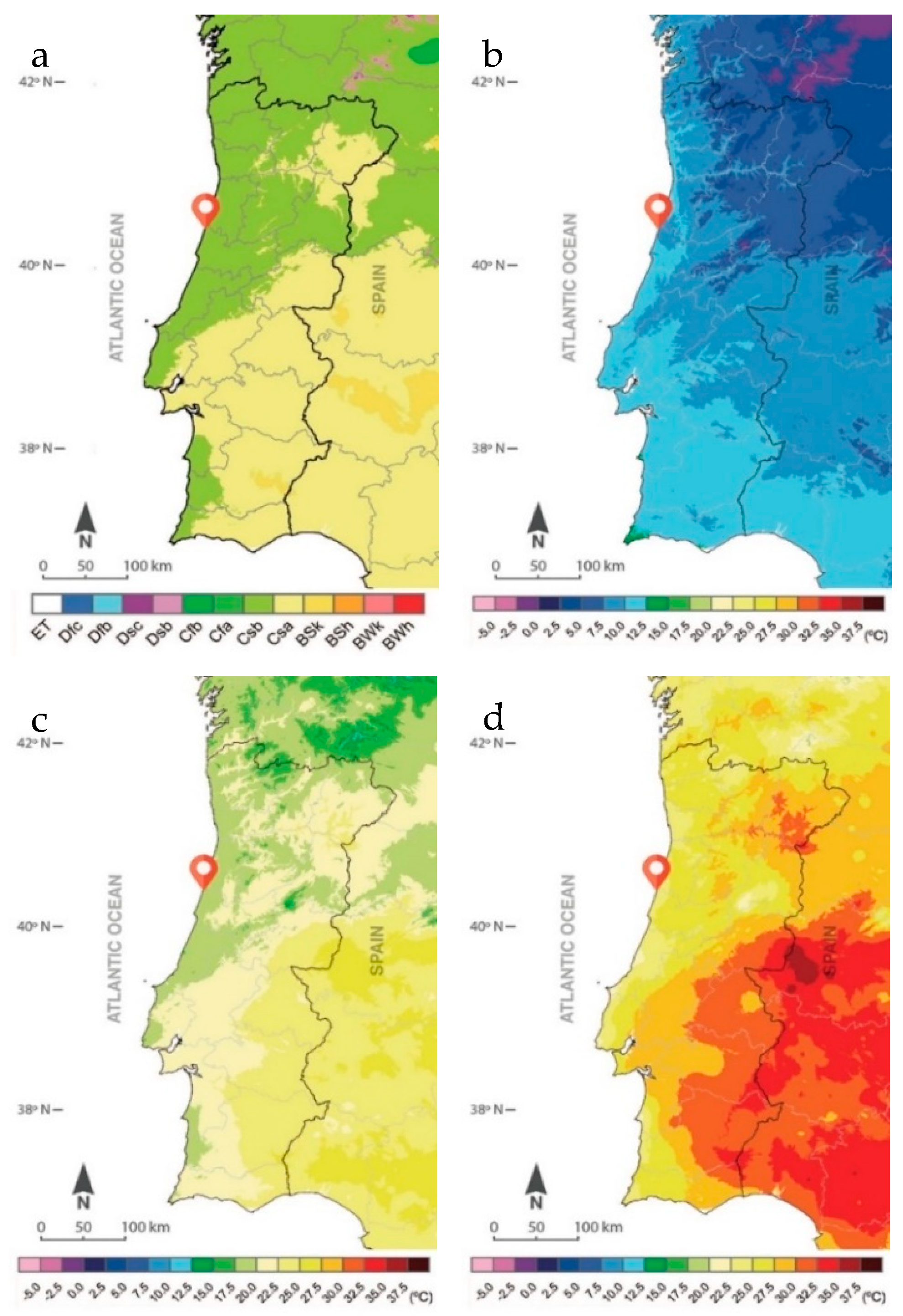
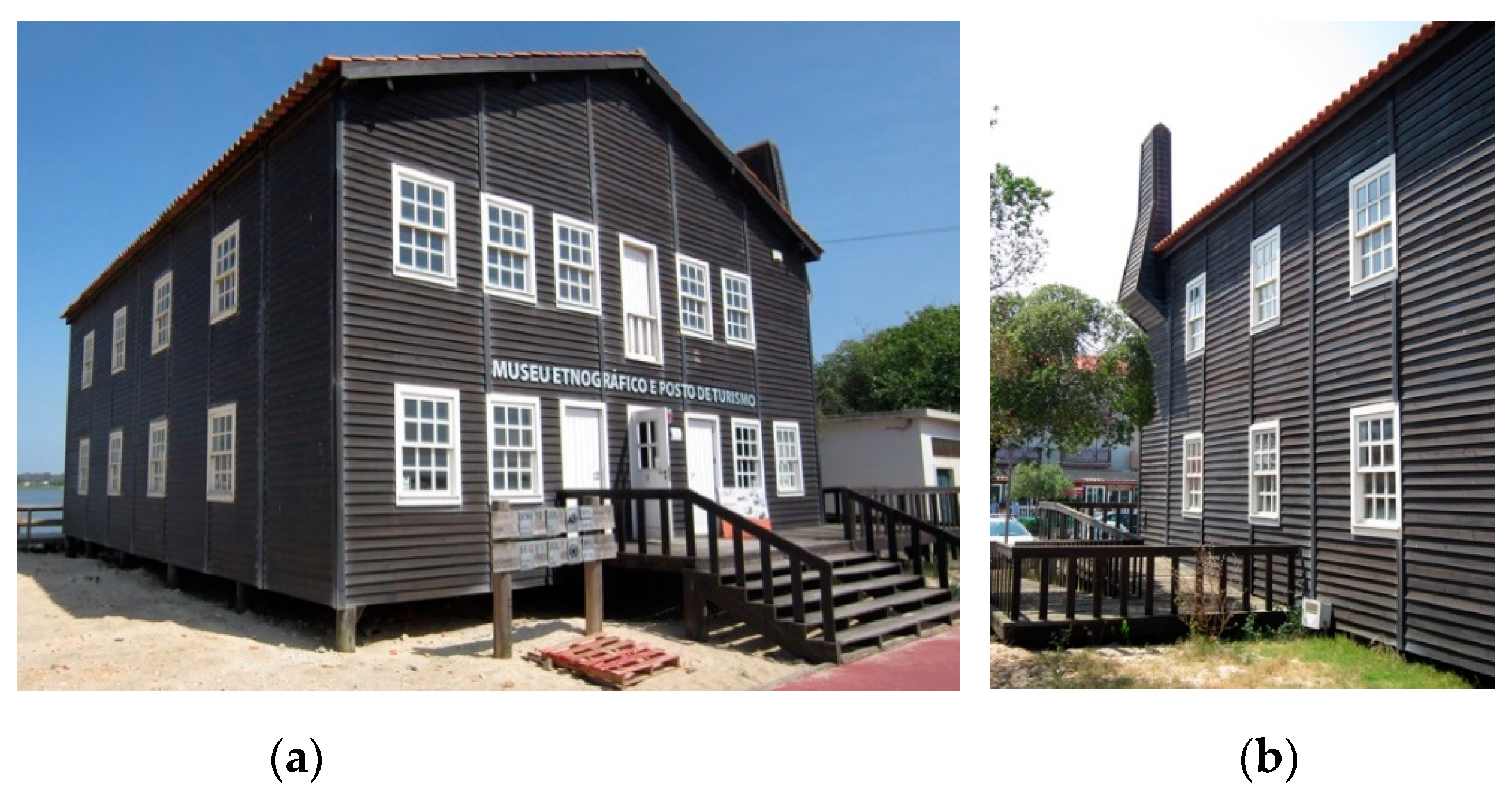
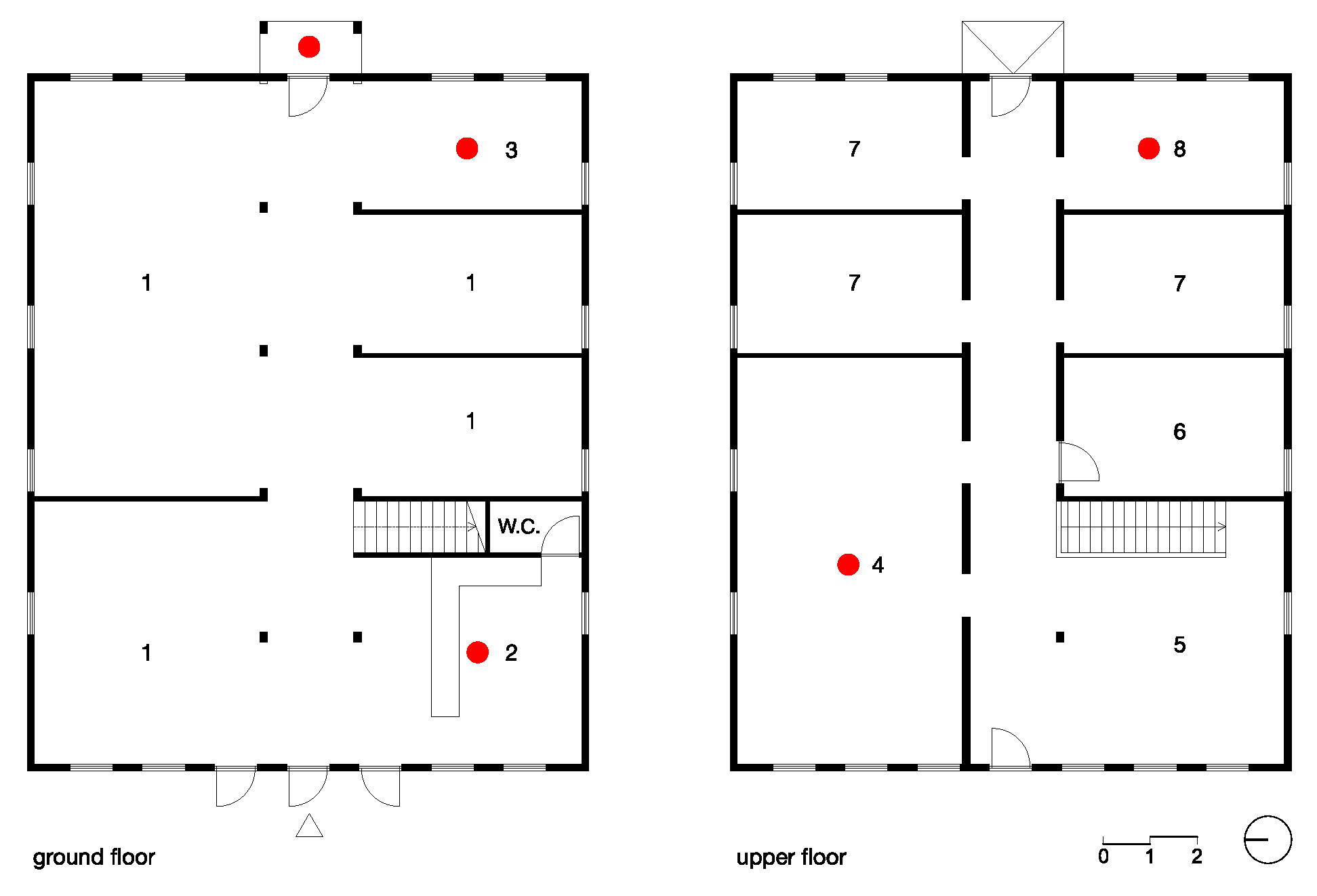
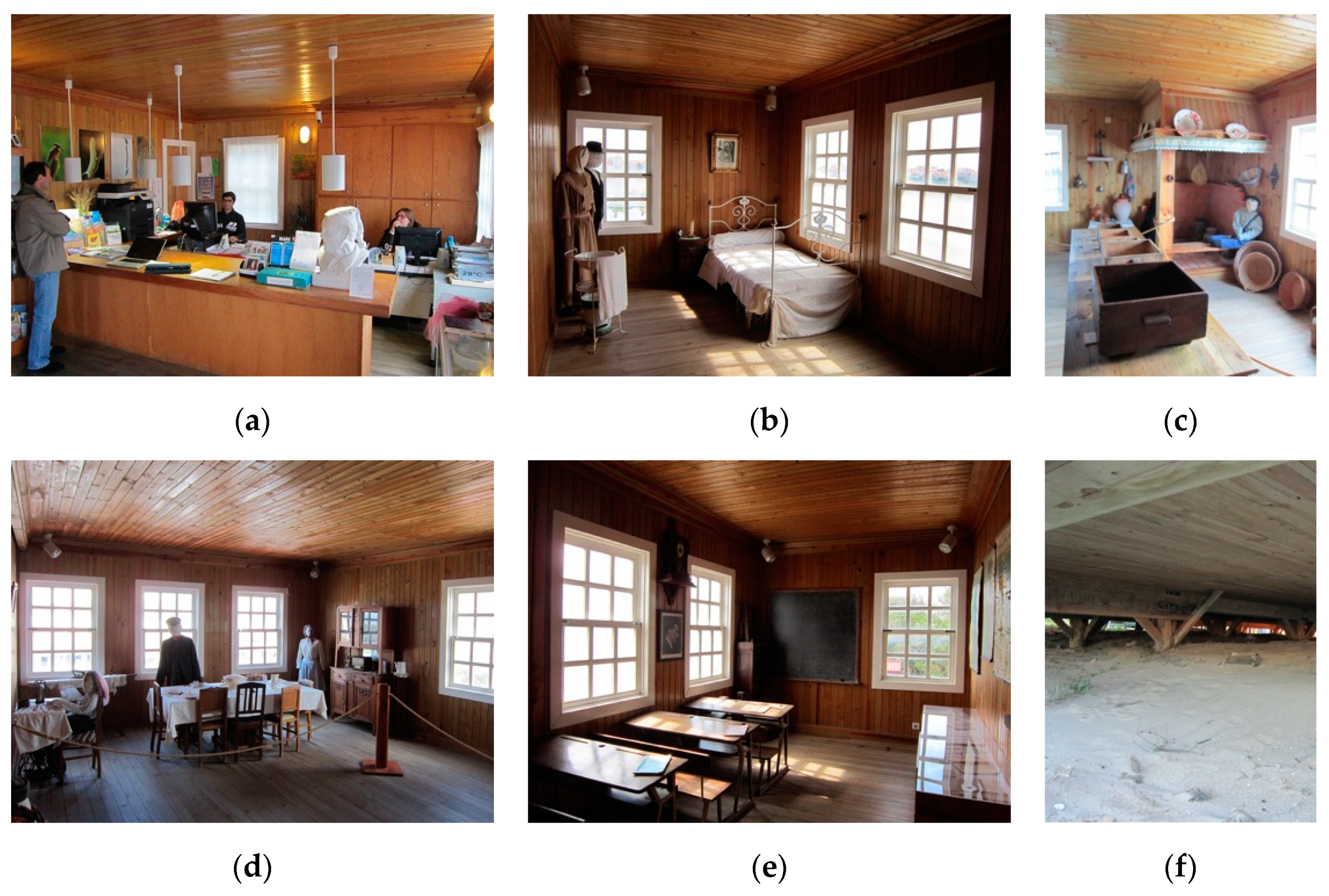
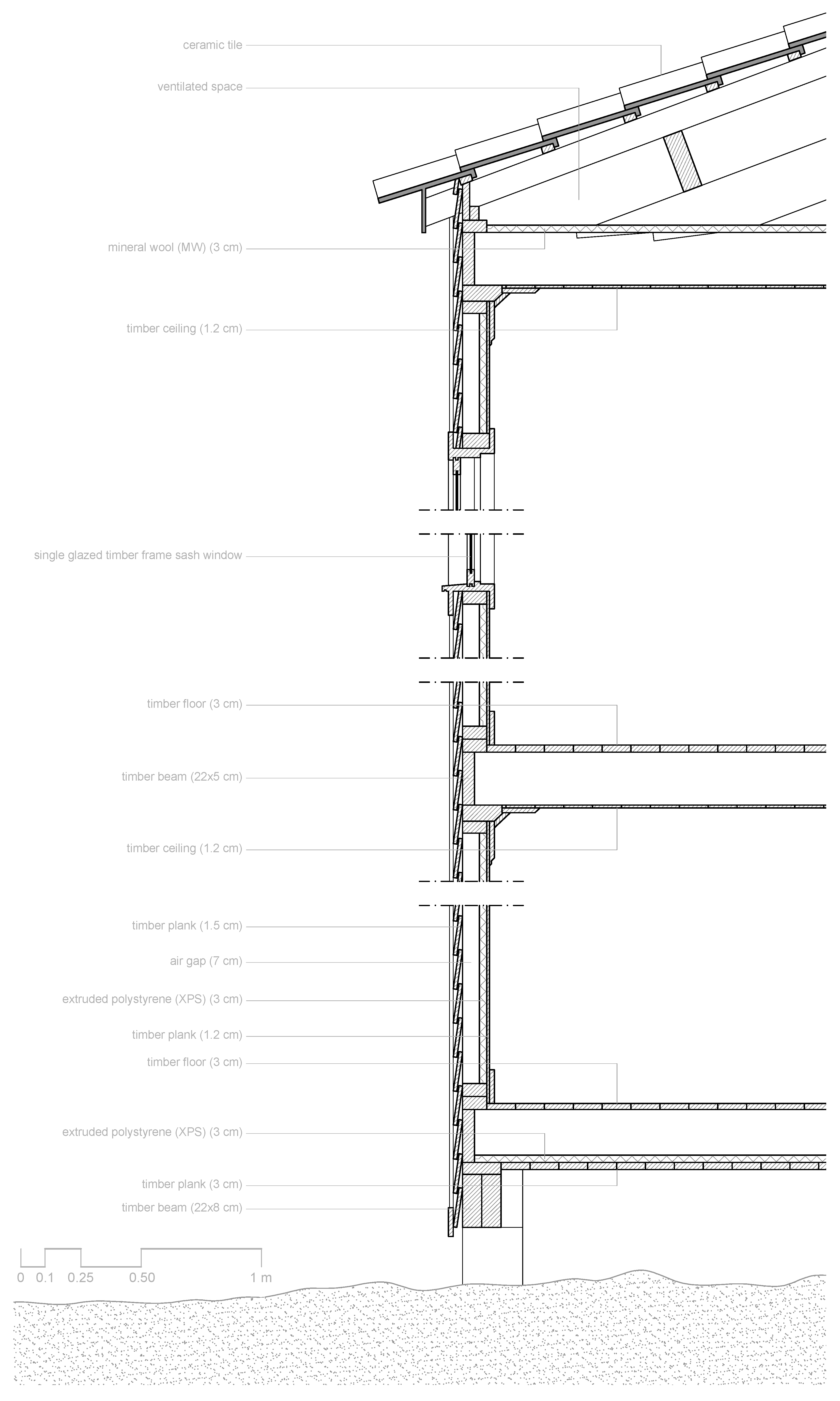

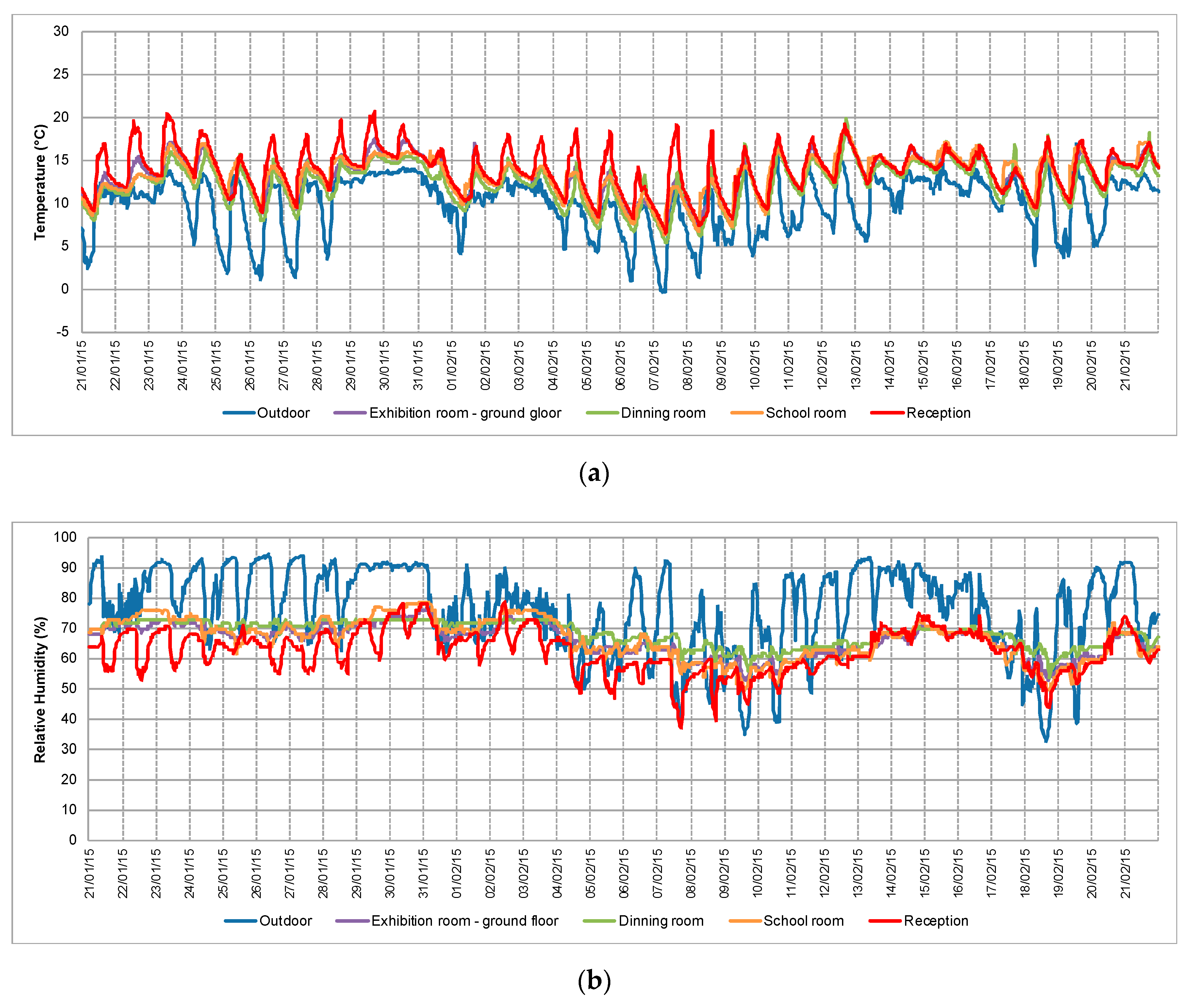

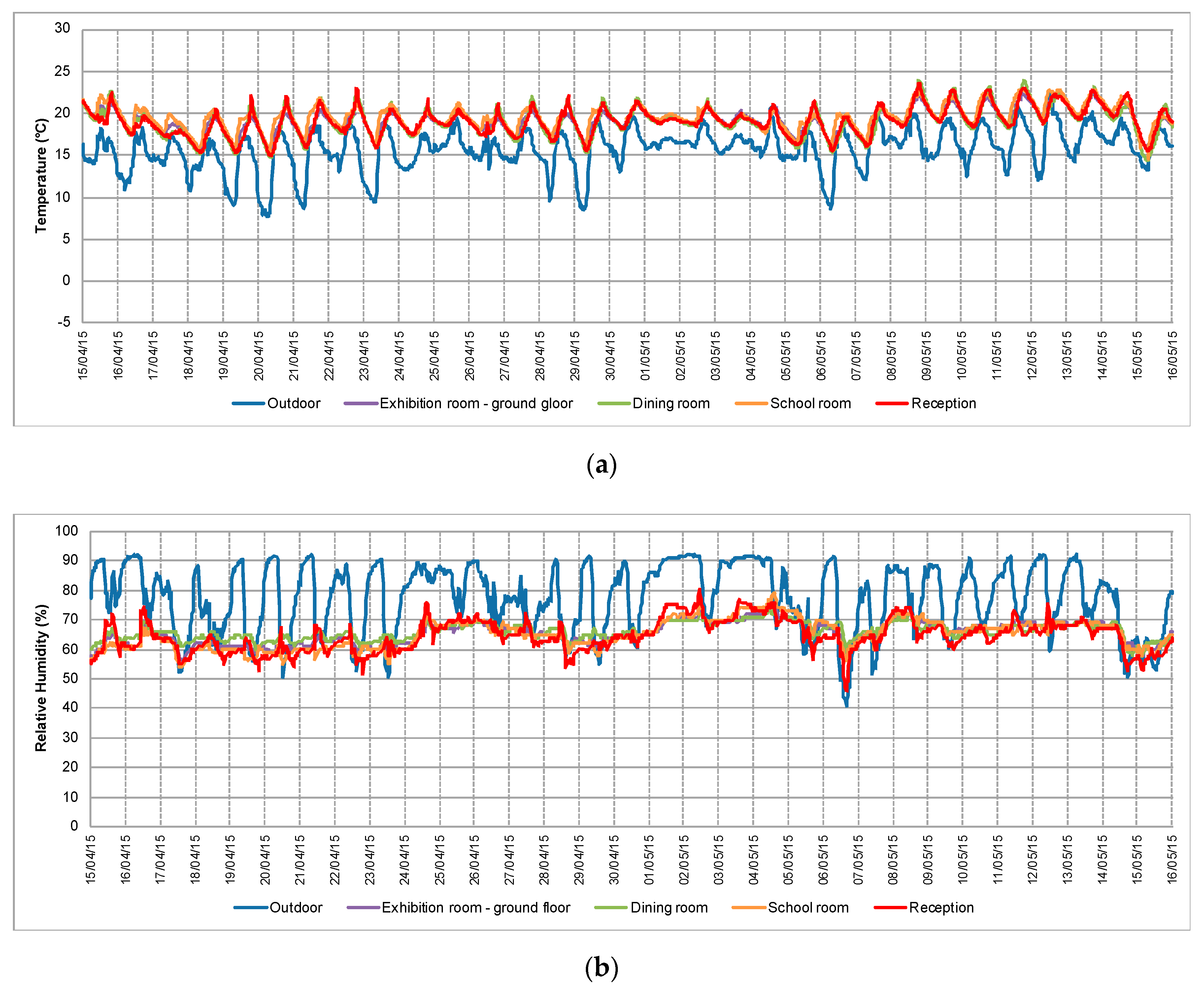
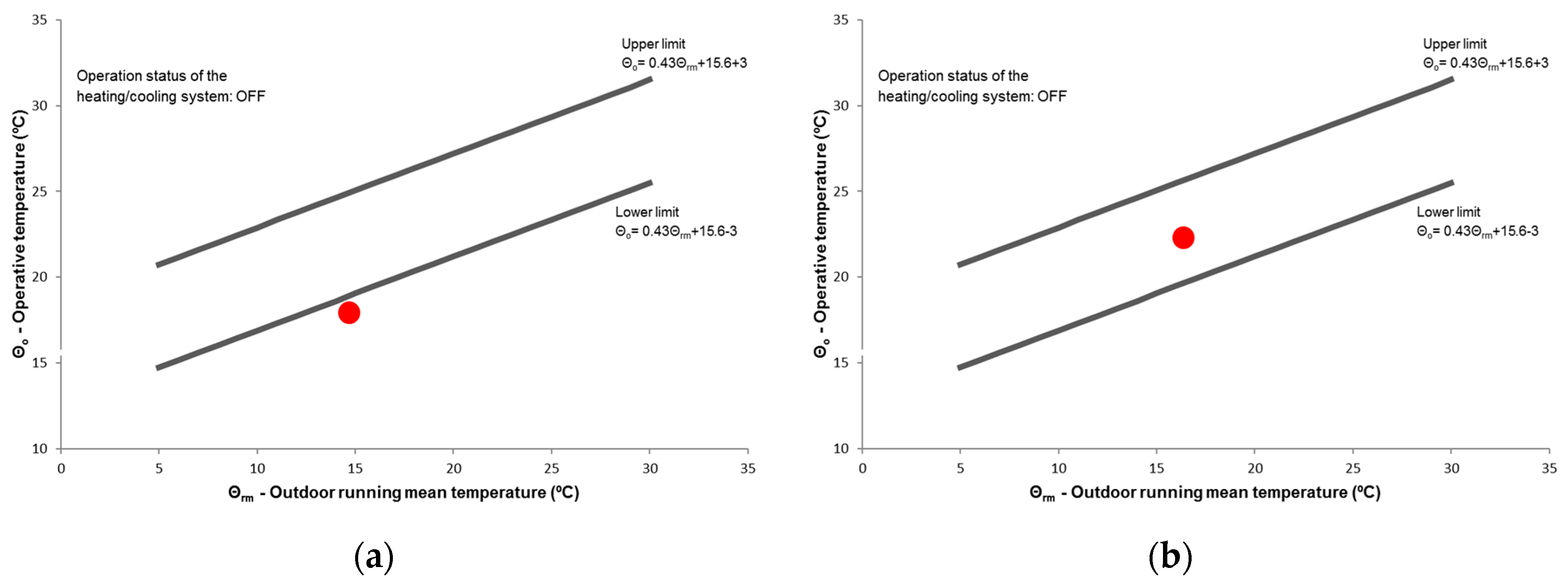
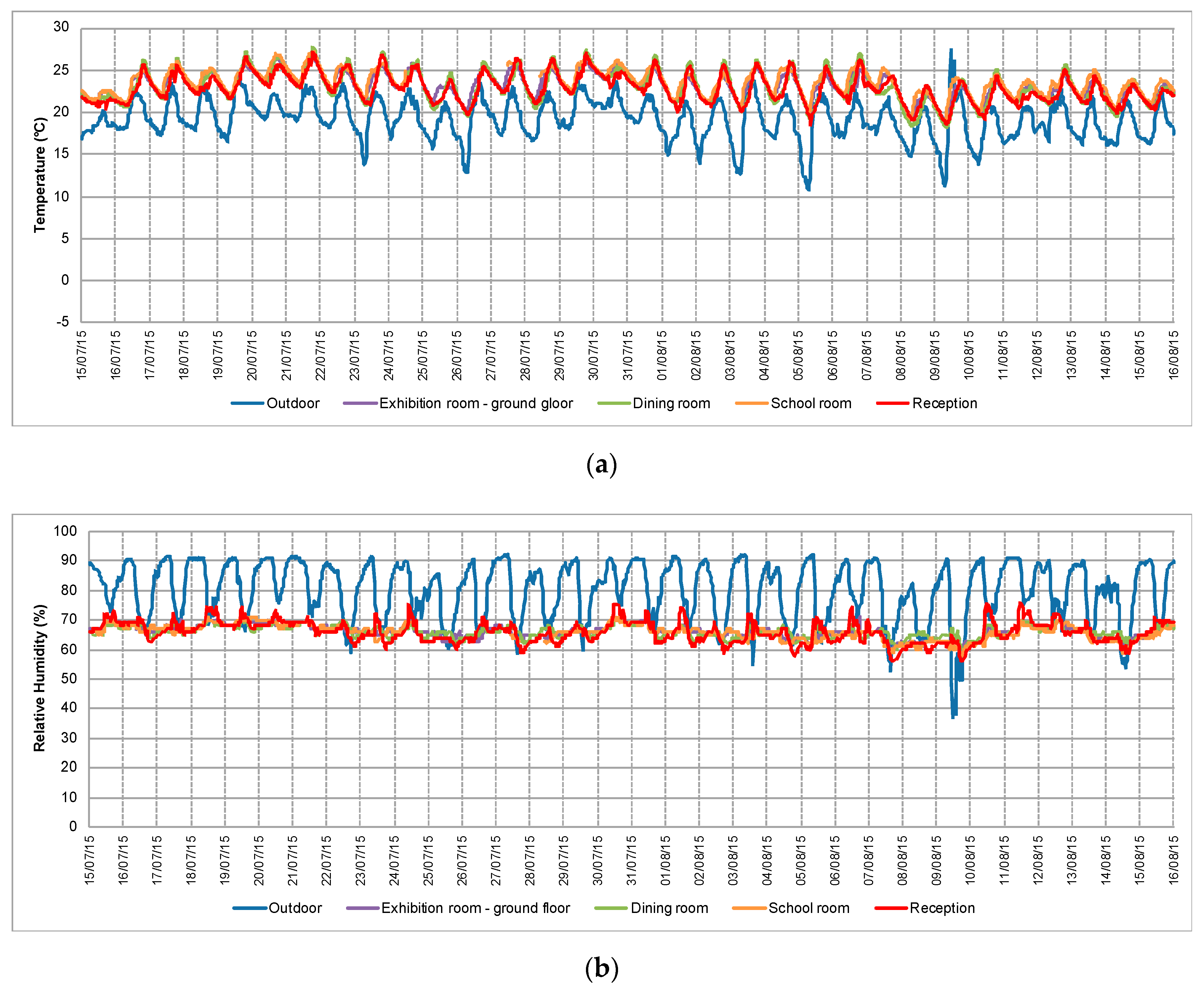
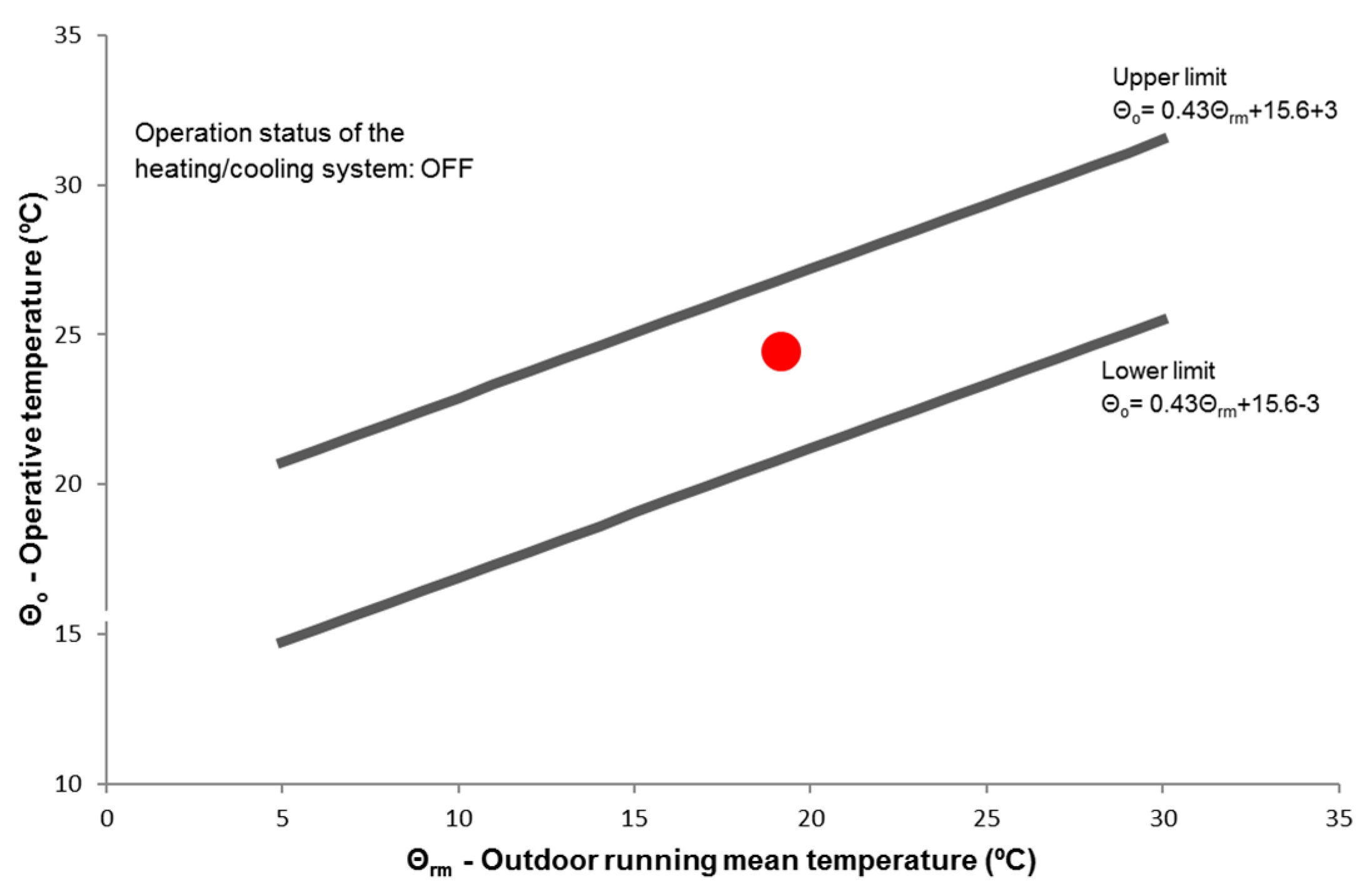
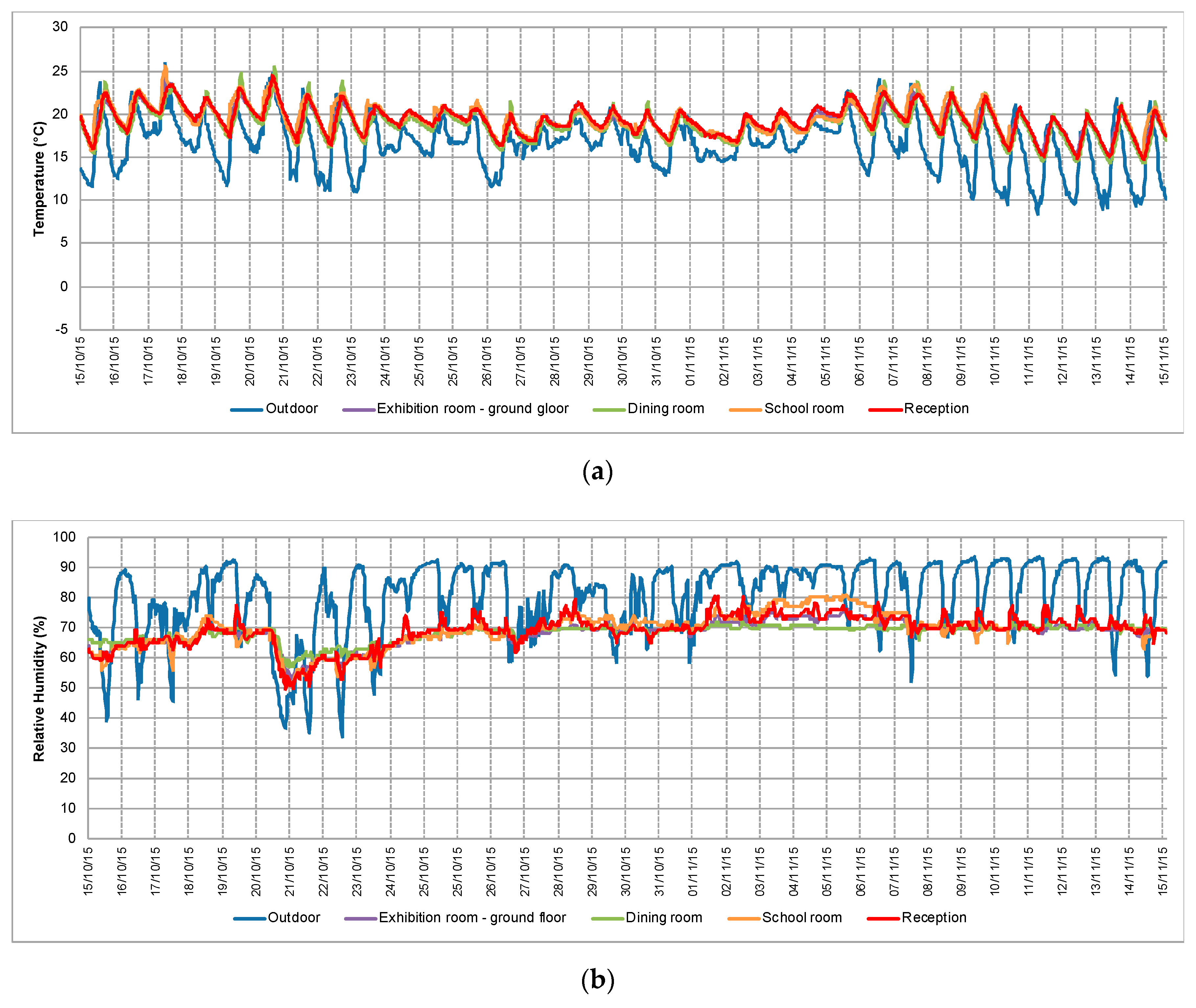

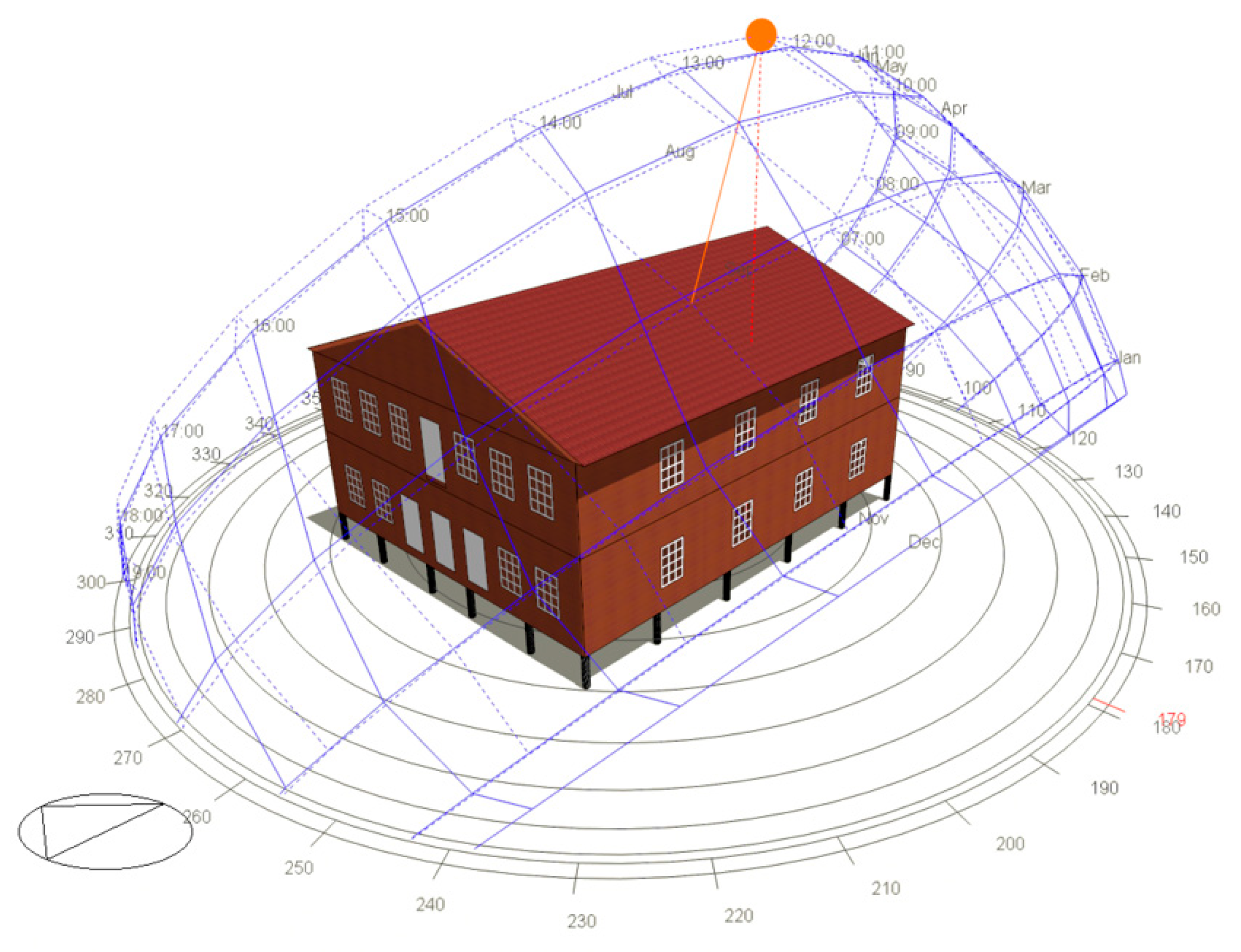
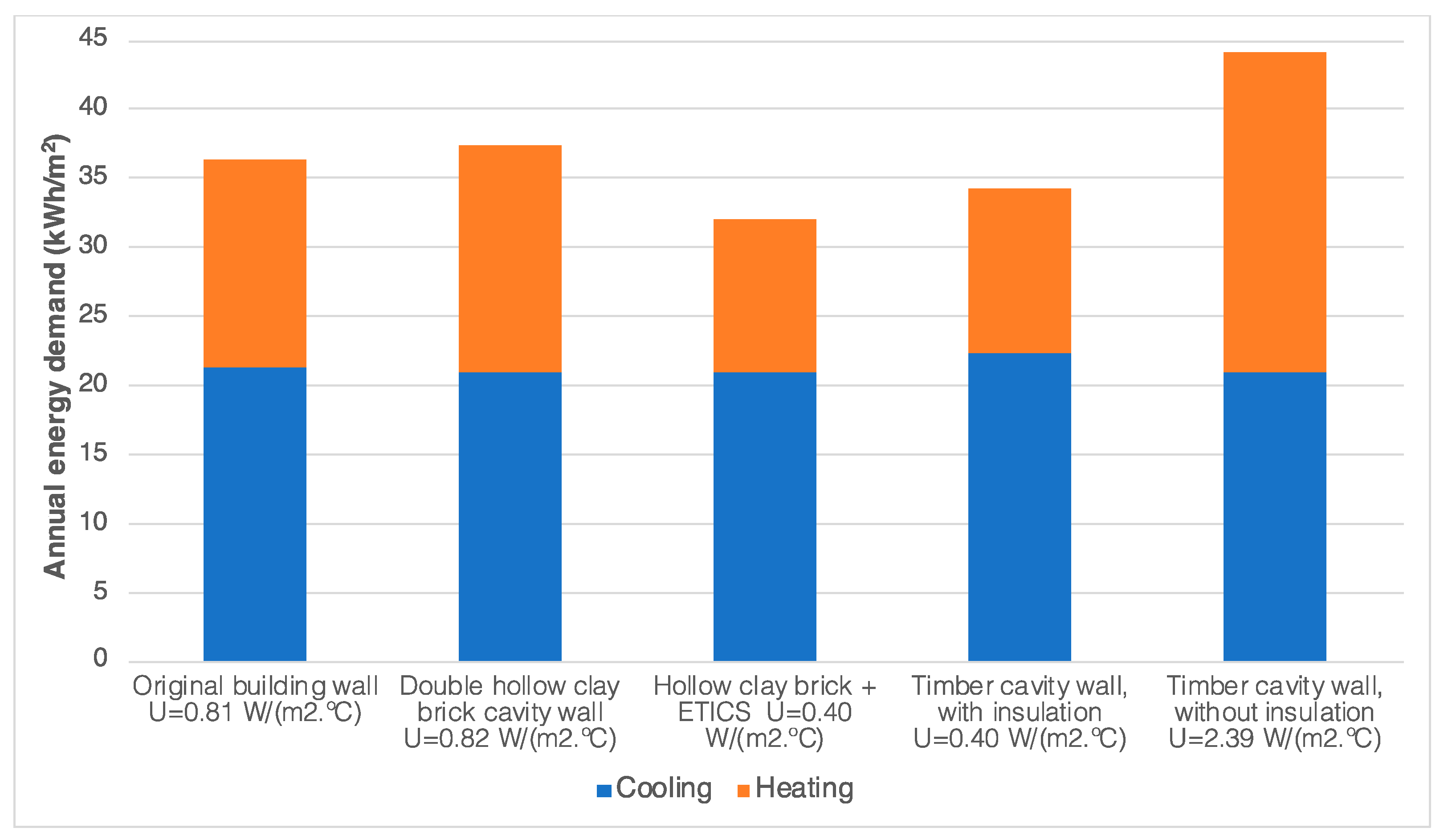
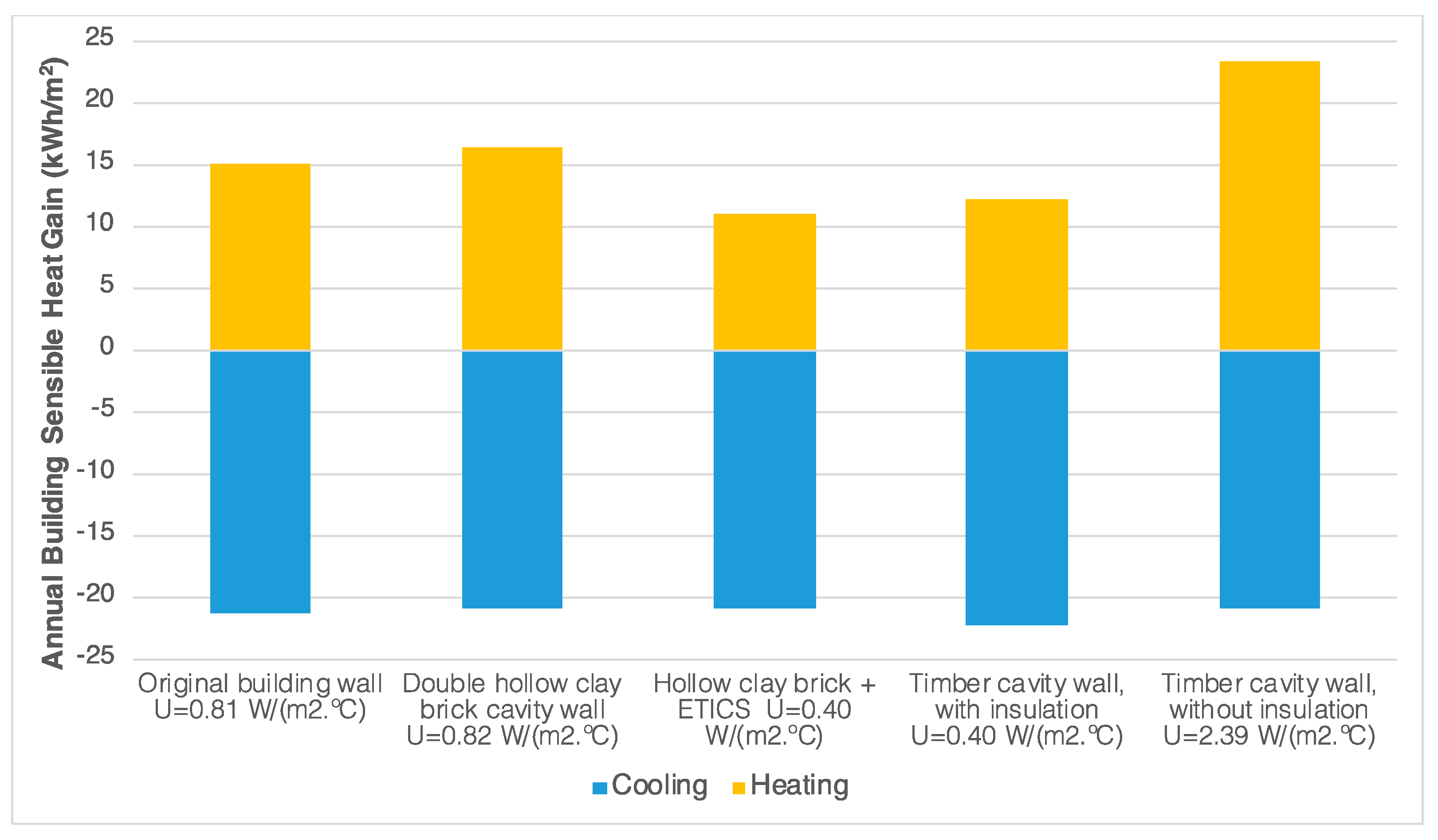
| Equipment | Specifications, Measurement Range and Accuracy | Location |
|---|---|---|
Thermal microclimate station (Delta OHM 32.1)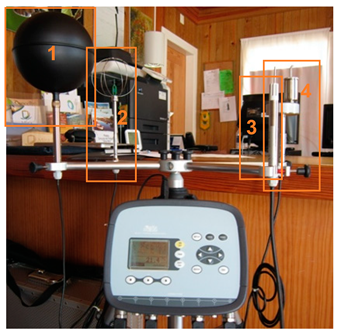 | Probes installed:
| Reception |
Thermo-hygrometer and datalogger (Klimalogg Pro, TFA 30.3039.IT) + Wireless thermo-hygrometer transmitters (model TFA 30.3180.IT) connected to the datalogger 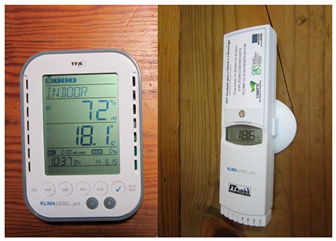 | Datalogger:
| Datalogger: Reception Transmitters: Exhibition room “Classroom” “Dining room” |
Weather station 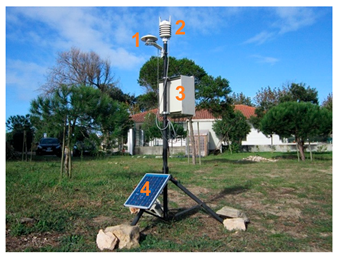 | Probes installed:
| Outdoor |
| Envelope Element | Materials | U-Value (W/(m2·°C)) [16] |
|---|---|---|
| External Walls | Exterior timber structure cavity wall made of overlapping wooden planks (1.5 cm); air gap (7 cm); thermal insulation (3 cm extruded polystyrene-XPS) and indoor timber planks (1.2 cm) | 0.81 |
| Ceiling (in contact with the ventilated roof) | Ventilated pitched roof (2 slopes, 20° angle), roofed with ceramic tiles, separated from indoor space by a horizontal timber slab with mineral wool (3 cm), air gap (20 cm) and timber planks (1.2 cm) | 0.84 |
| Floor (in contact with the exterior) | Elevated timber slab floor, made of timber planks (3 cm), thermal insulation (3 cm, XPS), air gap (22 cm) and indoor timber floor finishing (3 cm) | 0.61 |
| Doors | Solid timber (4 cm) | 3.0 |
| Windows (ground floor) | Single glazed timber frame guillotine windows, indoor translucent curtains | 4.3 1 |
| Windows (upper floor) | Single glazed timber frame guillotine windows (no solar protection) | 5.1 |
| Season | Use and Description | |
|---|---|---|
| Winter | heating/cooling | Heating (for all season). The pattern is: two oil-filled radiators in the reception (9 a.m.–5 p.m). |
| ventilation | Windows and doors closed. The main entrance door is sporadically opened when visitors enter/exit the building. | |
| shading | The curtains were usually closed on the ground floor. The upper floor windows do not have curtains. | |
| Spring | heating/cooling | Sporadic use of heating in spring cold days (1 oil-filled radiator). |
| ventilation | Main entrance door and reception window open during the day (9 a.m.–5 p.m.), particularly from May forward (sporadically closed in cool days). | |
| shading | The curtains were usually closed on the ground floor. The upper floor windows do not have curtains. | |
| Summer | heating/cooling | No cooling system was used. |
| ventilation | Main entrance door and reception window open during the day (9 a.m.–5 p.m.) | |
| shading | The curtains were usually closed on the ground floor. The upper floor windows do not have curtains. | |
| Autumn | heating/cooling | Heating (more frequent from middle October forward). The pattern is: One oil-filled radiator in the reception (9 a.m.– 5 p.m.), occasionally, two. |
| ventilation | Windows and doors closed. The main entrance door is sporadically opened to enter/exit the building. | |
| shading | The curtains were usually closed on the ground floor. The upper floor windows do not have curtains. |
| Winter | |||||
|---|---|---|---|---|---|
| Outdoor | Reception | “Dining Room” Room | Exhibition Room | “Classroom” | |
| Temperature (°C) | |||||
| Mean | 10.0 | 14.0 | 12.4 | 13.2 | 13.3 |
| Maximum | 17.0 | 20.7 | 19.9 | 18.4 | 18.8 |
| Minimum | −0.3 | 6.6 | 5.5 | 6.4 | 6.4 |
| Relative Humidity (%) | |||||
| Mean | 76.3 | 62.6 | 68.5 | 66.3 | 66.7 |
| Maximum | 94.5 | 79.0 | 74.0 | 77.0 | 79.0 |
| Minimum | 32.9 | 37.0 | 54.0 | 53.0 | 50.0 |
| Spring | |||||
|---|---|---|---|---|---|
| Outdoor | Reception | “Dining Room” | Exhibition Room | “Classroom” | |
| Temperature (°C) | |||||
| Mean | 15.7 | 19.1 | 19.0 | 19.1 | 19.6 |
| Maximum | 22.6 | 23.5 | 23.9 | 22.3 | 22.8 |
| Minimum | 7.7 | 14.9 | 14.4 | 15.2 | 14.5 |
| Relative Humidity (%) | |||||
| Mean | 77.2 | 64.6 | 66.2 | 65.5 | 65.1 |
| Maximum | 92.2 | 80.0 | 73.0 | 75.0 | 79.0 |
| Minimum | 41.1 | 46.0 | 58.0 | 56.0 | 54.0 |
| Summer | |||||
|---|---|---|---|---|---|
| Outdoor | Reception | “Dining Room” | Exhibition Room | “Classroom” | |
| Temperature (°C) | |||||
| Mean | 19.2 | 22.9 | 23.0 | 23.2 | 23.6 |
| Maximum | 27.3 | 27.2 | 27.8 | 26.6 | 27.2 |
| Minimum | 10.7 | 18.6 | 18.2 | 18.9 | 18.9 |
| Relative Humidity (%) | |||||
| Mean | 79.9 | 65.8 | 66.0 | 66.1 | 65.8 |
| Maximum | 92.3 | 76.0 | 70.0 | 71.0 | 71.0 |
| Minimum | 37.1 | 56.0 | 60.0 | 60.0 | 58.0 |
| Autumn | |||||
|---|---|---|---|---|---|
| Outdoor | Reception | “Dining Room” | Exhibition Room | “Classroom” | |
| Temperature (°C) | |||||
| Mean | 16.5 | 19.3 | 18.8 | 19.3 | 19.7 |
| Maximum | 25.8 | 24.4 | 25.4 | 24.3 | 25.6 |
| Minimum | 8.5 | 14.8 | 14.3 | 15.0 | 14.9 |
| Relative Humidity (%) | |||||
| Mean | 80.3 | 69.0 | 68.3 | 68.2 | 69.1 |
| Maximum | 93.3 | 80.0 | 72.0 | 76.0 | 81.0 |
| Minimum | 34.1 | 50.0 | 57.0 | 53.0 | 51.0 |
| Weather Data (EPW) [27] | Porto |
|---|---|
| Climate zone [15] Heating Degree Day (HDD) 1 Summer mean outdoor temperature | I2-V2 (Winter–I; Summer–V | 1-Mild; 2-Medium; 3–Harsh) 1304 20.9 °C |
| Internal heat gains [15] | 7 W/m2 |
| Maximum U-value for external walls [15] | 0.40 W/(m2·°C) |
| Air change rate | Minimum 0.6 ach |
| Heating/Cooling temperature setpoint [15,48] | 18–25 °C |
| Operation Schedules | |
| Internal gains | On 9 a.m. to 5 p.m. |
| Windows opening | Off 24/7 |
| Windows shading | Ground floor: On 24/7 Upper floor: No solar protection |
| Doors opening | Main entrance and first floor east façade balcony Summer: Open 9 a.m. to 5 p.m. All other days: Closed. |
| HVAC (simple 2) (18–25 °C) | On 7:30 a.m. to 5 p.m. |
| Mechanical ventilation (to assure the minimum 0.6 ach) | On 24/7 |
Publisher’s Note: MDPI stays neutral with regard to jurisdictional claims in published maps and institutional affiliations. |
© 2020 by the authors. Licensee MDPI, Basel, Switzerland. This article is an open access article distributed under the terms and conditions of the Creative Commons Attribution (CC BY) license (http://creativecommons.org/licenses/by/4.0/).
Share and Cite
Fernandes, J.; Mateus, R.; Gervásio, H.; Silva, S.M.; Branco, J.; Almeida, M. Thermal Performance and Comfort Conditions Analysis of a Vernacular Palafitic Timber Building in Portuguese Coastline Context. Sustainability 2020, 12, 10484. https://doi.org/10.3390/su122410484
Fernandes J, Mateus R, Gervásio H, Silva SM, Branco J, Almeida M. Thermal Performance and Comfort Conditions Analysis of a Vernacular Palafitic Timber Building in Portuguese Coastline Context. Sustainability. 2020; 12(24):10484. https://doi.org/10.3390/su122410484
Chicago/Turabian StyleFernandes, Jorge, Ricardo Mateus, Helena Gervásio, Sandra Monteiro Silva, Jorge Branco, and Manuela Almeida. 2020. "Thermal Performance and Comfort Conditions Analysis of a Vernacular Palafitic Timber Building in Portuguese Coastline Context" Sustainability 12, no. 24: 10484. https://doi.org/10.3390/su122410484
APA StyleFernandes, J., Mateus, R., Gervásio, H., Silva, S. M., Branco, J., & Almeida, M. (2020). Thermal Performance and Comfort Conditions Analysis of a Vernacular Palafitic Timber Building in Portuguese Coastline Context. Sustainability, 12(24), 10484. https://doi.org/10.3390/su122410484










